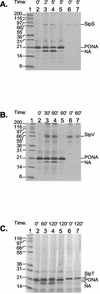Molecular analysis of Phr peptide processing in Bacillus subtilis
- PMID: 12897006
- PMCID: PMC166482
- DOI: 10.1128/JB.185.16.4861-4871.2003
Molecular analysis of Phr peptide processing in Bacillus subtilis
Abstract
In Bacillus subtilis, an export-import pathway regulates production of the Phr pentapeptide inhibitors of Rap proteins. Processing of the Phr precursor proteins into the active pentapeptide form is a key event in the initiation of sporulation and competence development. The PhrA (ARNQT) and PhrE (SRNVT) peptides inhibit the RapA and RapE phosphatases, respectively, whose activity is directed toward the Spo0F approximately P intermediate response regulator of the sporulation phosphorelay. The PhrC (ERGMT) peptide inhibits the RapC protein acting on the ComA response regulator for competence with regard to DNA transformation. The structural organization of PhrA, PhrE, and PhrC suggested a role for type I signal peptidases in the processing of the Phr preinhibitor, encoded by the phr genes, into the proinhibitor form. The proinhibitor was then postulated to be cleaved to the active pentapeptide inhibitor by an additional enzyme. In this report, we provide evidence that Phr preinhibitor proteins are subject to only one processing event at the peptide bond on the amino-terminal end of the pentapeptide. This processing event is most likely independent of type I signal peptidase activity. In vivo and in vitro analyses indicate that none of the five signal peptidases of B. subtilis (SipS, SipT, SipU, SipV, and SipW) are indispensable for Phr processing. However, we show that SipV and SipT have a previously undescribed role in sporulation, competence, and cell growth.
Figures






Similar articles
-
Bacillus subtilis RapA phosphatase domain interaction with its substrate, phosphorylated Spo0F, and its inhibitor, the PhrA peptide.J Bacteriol. 2012 Mar;194(6):1378-88. doi: 10.1128/JB.06747-11. Epub 2012 Jan 20. J Bacteriol. 2012. PMID: 22267516 Free PMC article.
-
Differential processing of propeptide inhibitors of Rap phosphatases in Bacillus subtilis.J Bacteriol. 2000 Jan;182(2):303-10. doi: 10.1128/JB.182.2.303-310.2000. J Bacteriol. 2000. PMID: 10629174 Free PMC article.
-
TPR-mediated interaction of RapC with ComA inhibits response regulator-DNA binding for competence development in Bacillus subtilis.Mol Microbiol. 2003 Sep;49(6):1509-22. doi: 10.1046/j.1365-2958.2003.03659.x. Mol Microbiol. 2003. PMID: 12950917
-
Pentapeptide regulation of aspartyl-phosphate phosphatases.Peptides. 2001 Oct;22(10):1541-7. doi: 10.1016/s0196-9781(01)00490-9. Peptides. 2001. PMID: 11587783 Review.
-
Aspartyl-phosphate phosphatases deactivate the response regulator components of the sporulation signal transduction system in Bacillus subtilis.Mol Microbiol. 1996 Mar;19(6):1151-7. doi: 10.1111/j.1365-2958.1996.tb02460.x. Mol Microbiol. 1996. PMID: 8730857 Review.
Cited by
-
Genome-wide transcriptional analysis of the phosphate starvation stimulon of Bacillus subtilis.J Bacteriol. 2005 Dec;187(23):8063-80. doi: 10.1128/JB.187.23.8063-8080.2005. J Bacteriol. 2005. PMID: 16291680 Free PMC article.
-
Structural basis of response regulator inhibition by a bacterial anti-activator protein.PLoS Biol. 2011 Dec;9(12):e1001226. doi: 10.1371/journal.pbio.1001226. Epub 2011 Dec 27. PLoS Biol. 2011. PMID: 22215984 Free PMC article.
-
Identification of residues important for cleavage of the extracellular signaling peptide CSF of Bacillus subtilis from its precursor protein.J Bacteriol. 2008 Oct;190(20):6668-75. doi: 10.1128/JB.00910-08. Epub 2008 Aug 8. J Bacteriol. 2008. PMID: 18689487 Free PMC article.
-
Research advances in the identification of regulatory mechanisms of surfactin production by Bacillus: a review.Microb Cell Fact. 2024 Apr 2;23(1):100. doi: 10.1186/s12934-024-02372-7. Microb Cell Fact. 2024. PMID: 38566071 Free PMC article. Review.
-
The Large pBS32/pLS32 Plasmid of Ancestral Bacillus subtilis.J Bacteriol. 2020 Aug 25;202(18):e00290-20. doi: 10.1128/JB.00290-20. Print 2020 Aug 25. J Bacteriol. 2020. PMID: 32601071 Free PMC article. Review.
References
-
- Bligh, E. G., and W. J. Dyer. 1959. A rapid method of total lipid extraction and purification. Can. J. Biochem. Physiol. 37:911-917. - PubMed
-
- Burkholder, W. F., I. Kurtser, and A. D. Grossman. 2001. Replication initiation proteins regulate a developmental checkpoint in Bacillus subtilis. Cell 104:269-279. - PubMed
-
- Carlos, J. L., M. Paetzel, G. Brubaker, A. Karla, C. M. Ashwell, M. O. Lively, G. Cao, P. Bullinger, and R. E. Dalbey. 2000. The role of the membrane-spanning domain of type I signal peptidases in substrate cleavage site selection. J. Biol. Chem. 275:38813-38822. - PubMed
-
- Chatterjee, S., D. Suciu, R. E. Dalbey, P. C. Kahn, and M. Inouye. 1995. Determination of Km and kcat for signal peptidase I using a full length secretory precursor, pro-OmpA-nuclease A. J. Mol. Biol. 245:311-314. - PubMed
Publication types
MeSH terms
Substances
Grants and funding
LinkOut - more resources
Full Text Sources
Other Literature Sources
Molecular Biology Databases

